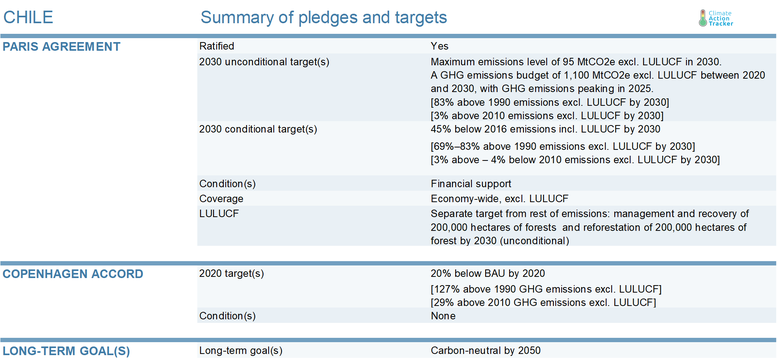Pledges And Targets
Summary table

Paris Agreement targets
Chile’s updated 2020 NDC was submitted to the UNFCCC in April 2020 (Government of Chile, 2020). It includes two emissions reduction targets for 2030:
- Unconditional:
- This target includes three components:
- Absolute target of 95 MtCO2e in 2030, excl. emissions or removals from the Land Use, Land Use Change and Forestry (LULUCF) sector;
- GHG emissions budget of 1100 MtCO2e between 2020 and 2030;
- A peak year for GHG emissions: 2025.
- Three targets for the LULUCF sector:
- Sustainable management and recovery of 200 000 hectares of native forest, equivalent to a GHG emissions capture between 0.9 and 1.2 MtCO2e/yr by 2030;
- Reforestation of 200 000 hectares of forest, from which at least half correspond to permanent forest coverage, from which at least 70 000 hectares should be native species. This is equivalent to a GHG emissions capture between 3 and 3.4 MtCO2e/yr by 2030;
- Reduce emissions from deforestation and land degradation of native forest by 25% by 2030, taking average emissions between 2001-2013.
- This target includes three components:
According to our calculations, by implementing all of its planned policies, Chile could peak its emissions in 2023 ─ two years earlier than the proposed peak year of 2025 ─ which would be a remarkable achievement and set up the country as a frontrunner on climate action. Under this scenario the carbon budget between 2020 and 2030 would be 6-17% lower than the carbon budget presented in the 2020 NDC.
- Conditional on international finance:
- Reduction of up to 45% net GHG emissions (i.e. incl. LULUCF) from 2016 levels, by 2030. Depending on the expected contribution of the LULUCF sector for this target (i.e. share of CO2 removals), this target could reduce emissions excluding LULUCF to between 95 MtCO2e and 88 MtCO2e.
The 2020 NDC links the 2030 target to the long-term goal for carbon-neutrality by 2050, as well as to planning processes involving governance, existing and future strategies including the “Long-term Climate Strategy 2050.” According to the NDC text, the current NDC planning and update process should allow for the NDC and its consecutive iterations to be intermediate milestones to achieve the 2050 neutrality goal, i.e. taking into account the necessary measures to reach this (Government of Chile, 2020).
It also includes a target to reduce black carbon emissions by at least 25% below 2016 emission levels, by 2030; and two adaptation targets: one including administrative measures on the sectoral adaptation plans and a second including the sectoral adaptation targets.
Black Carbon and Chile’s NDC
Chile’s 2020 NDC update includes a target to reduce black carbon emissions, which has substantial co-benefits for human health. However, reductions in black carbon are generally not additional to those leading to reductions in CO2, because large fractions of black carbon emissions stem from the same emission sources as CO2. emission reduction policies therefore often reduce CO2 and black carbon simultaneously, and this is already included in calculations of the emissions reductions required to hold warming well below 2°C globally, like the “emissions gap” and “fair share” reductions (see next section on Fair Share).
In its Fifth Assessment Report (AR5), the IPCC does not provide calculations of Global Warming Potential for black carbon comparable to those provided for greenhouse gases, merely noting the inherent difficulties in doing so and limiting itself to displaying estimates from the pre-AR5 literature.
For information on Chile’s 2019 draft NDC or its original submission in 2017, see our comparison assessment of Chile’s NDCs and the previous country assessment of the 2017 NDC submission.
2020 pledge
Chile proposed to undertake NAMAs to reach an emissions reduction of 20% below BAU including LULUCF in 2020 (as projected from 2007). We estimate this is an absolute pledged emissions level of 122 MtCO2e in 2020 excluding emissions and sinks from LULUCF. This is equivalent to an increase of 134% from 1990 GHG emissions levels, excluding LULUCF. According to our current policy projections, Chile will overachieve its 2020 pledge.
Long-term target
In June 2019, Chile announced its aim to achieve carbon neutrality by 2050 (Gobierno de Chile, 2019b). This was later reflected in its 2020 NDC (Government of Chile, 2020) and the draft Climate Change Framework Law currently under discussion in the National Congress. The main objectives of this framework law are a transition to a low emissions development towards achieving GHG neutrality in 2050, increasing resilience against climate change effects, and complying with international climate change commitments. The long-term goals of the current draft bill should be achieved by the implementation of two equally relevant lines of action: i) reaching a sustained decrease in GHG emissions; and ii) increasing and maintaining natural carbon sinks. If approved, this bill would enshrine Chile’s 2050 GHG emissions neutrality target into legislation.
A recently-published study from both Ministry of Energy and Ministry of Environment, gives indication of the planned LULUCF contribution to the neutrality target: Chile expects carbon sinks to contribute 50% of the emissions reduction needed to achieve the 2050 neutrality target (Ministerio de Energia del Gobierno de Chile, 2020). This can pose a risk, given the high chances of carbon loss through deforestation or natural disturbance and eventual competition for land. Despite significantly relying on forestry sinks, we estimate 2050 emissions would be consistent with the CAT rating category of 2°C Paris Agreement compatible for Chile.
Further analysis
Latest publications
Stay informed
Subscribe to our newsletter




